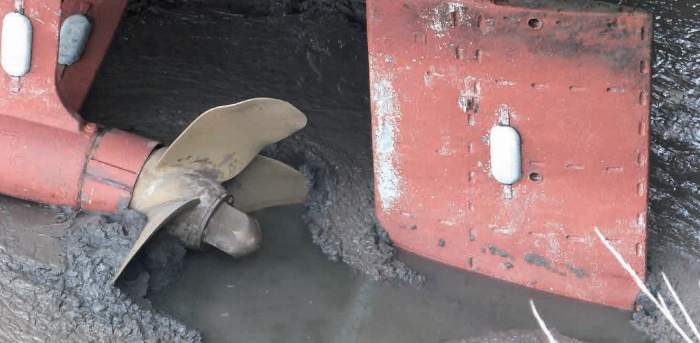The UK MAIB shared valuable lessons learned from an incident involving a ferry which ran over the submerged remains of a derelict mooring dolphin. The ferry’s port propeller, shaft, stern seal and rudder were damaged by the contact. MAIB noted that navigating by eye in a narrow channel is common practice, but it can be misleading, even in familiar waters.
The incident
It was a fine summer’s day and passengers on board a ferry were taking in the sights of a city while enjoying a scheduled river and canal cruise. As the ferry made its way towards a lock entrance, the bridge team were called by radio with the request that the ferry’s approach be delayed by a few minutes to allow an outbound vessel to clear. The ferry’s master reduced speed and told the mate, who was on the helm, to steer towards the eastern side of the channel to give the outbound vessel plenty of sea room.
Entering the lock was ‘business as usual’, and the ferry’s master and the mate on the helm chatted as the distance to the lock decreased and the ferry moved to the eastern side of the navigable channel as planned. The bridge team were familiar with the area and were navigating by eye. By the time the outbound vessel was clear of the lock entrance, the ferry was much further to the east than usual, and the mate was quick to apply starboard helm to line up the ferry for its approach.
Seconds after the ferry had started to turn, the crew and passengers felt the vessel vibrate and heel to starboard. The ferry’s engines stopped, so an anchor was immediately let go to prevent the ferry from drifting towards dangers. After the engineer managed to re-start one of the engines, the ferry was manoeuvred alongside and the passengers were disembarked. There were no injuries.
The ferry had run over the submerged remains of a mooring dolphin, which was the northerly-most of several charted derelict dolphins on the eastern side of the approach to the lock. The ferry’s port propeller, shaft, stern seal and rudder were damaged by the contact.
Lessons learned
- For most of the time, voyages are routine, but when things change and tried and tested plans are modified, the margins for error frequently decrease. In such situations, a few minutes taken to look at the chart and think through the ramifications of any change of plan or ‘doing something out of the ordinary’ is usually time well spent.
- Navigating by eye in a narrow channel is common practice, but it can be misleading – even in familiar waters. Therefore, when passing close to underwater hazards or shoal water, the use of more accurate navigation systems, such as electronic charts, provides good assurance.
- Being prepared to act quickly and positively in an emergency is just as important as preventing an accident in the first place. Realistic drills, well-considered and rehearsed procedures, and occasionally thinking ‘what would I do if ?’ are key to instinctive actions if things go wrong.































































